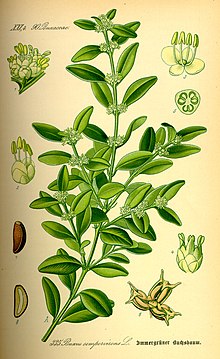Buxales
| Buxales | |
|---|---|
 |
|
| Buxus sempervirens | |
| Scientific classification | |
| Kingdom: | Plantae |
| Clade: | Angiosperms |
| Clade: | Eudicots |
| Order: |
Buxales Takht. ex Reveal |
| Families | |
|
|
The Buxales are a small order of eudicot flowering plants, recognized by the APG III system of 2009. The order includes the family Buxaceae; the families Didymelaceae and Haptanthaceae may also be recognized or may be included in the Buxaceae. Many members of the order are evergreen shrubs or trees, although some are herbaceous perennials. They have separate "male" (staminate) and "female" (carpellate) flowers, mostly on the same plant (i.e. they are mostly monoecious). Some species are of economic importance either for the wood they produce or as ornamental plants.
The Buxales have relatively few obvious shared features distinguishing them from related groups of plants (i.e. few obvious synapomorphies). One is the presence of a particular type of alkaloid or pseudoalkaloid, pregnane steroids. They have unisexual flowers (i.e. separate staminate or "male" flowers and carpellate or "female" flowers), most being monoecious. The flowers are small, less than 7 mm across. The tepals have a single vascular bundle (trace). Other characters common to the order include leaves with entire (untoothed) margins, flowers arranged in racemes, small styles capable of receiving pollen along their entire length rather than having a separate stigma, one to two ovules per carpel, and seeds with testae (coats) made up of several cell layers.
Didymeles, the sole genus in the family Didymelaceae, consists of two species of evergreen tree occurring only in Madagascar. It is dioecious, i.e. with staminate and carpellate flowers on separate plants. Buxaceae (including Haptanthaceae) is more diverse, with five or six genera totalling about 115 species, and is found in most temperate and tropical areas of the world. Most species are evergreen shrubs or small trees, but some (such as those of Pachysandra) are herbaceous perennials.
...
Wikipedia
